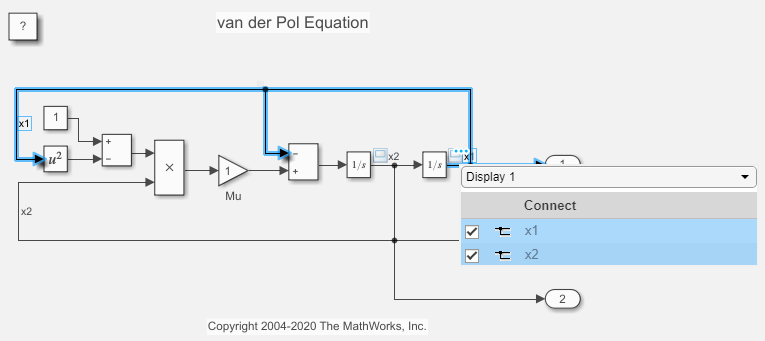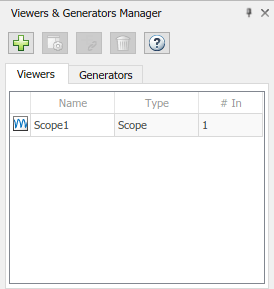Floating Scope 和波形查看器任务
本页上的示例说明常见的 Floating Scope 模块和波形查看器过程。
将 Floating Scope 模块添加到模型和连接信号
要从 Simulink® 模块库中添加 Floating Scope 模块,请执行以下操作:
在仿真选项卡中,点击库浏览器
 。
。从 Simulink / Sinks 中,将 Floating Scope 模块的副本拖到您的模型中。
要将信号连接到浮动示波器,请执行以下操作:
双击 Floating Scope 模块。
在示波器窗口工具栏的示波器窗格中,点击信号选择器
 。
。Simulink 编辑器画布变为灰色,表示您可以通过交互方式选择要连接到示波器的信号。
选择要连接到示波器的信号。要选择多个信号,请点击并拖动。
在连接对话框中,选中要连接的信号旁边的复选框。

对于具有多个显示画面(子图)的示波器,请从“连接”对话框顶部的下拉列表中选择所需的显示画面,并连接信号。
点击 Simulink 画布右上角的 X。
您的信号现在已连接到浮动示波器。运行仿真以查看绘制的信号。
将波形查看器添加到信号
选择要查看的信号。
在仿真选项卡的准备部分中,点击添加查看器。
从“添加查看器”窗口中,选择一个查看器。例如,点击示波器。
将信号添加到现有浮动示波器或波形查看器
将信号连接到现有 Floating Scope 或波形查看器。
通过双击 Floating Scope 模块或 Scope Viewer 图标
 打开示波器。
打开示波器。在示波器窗格中,点击信号选择器
 。
。Simulink 编辑器画布变为灰色,表示您可以通过交互方式选择要连接到示波器的信号。
选择要连接到示波器的信号。要选择多个信号,请点击并拖动。
在连接对话框中,选中要连接的信号旁边的复选框。

对于具有多个显示画面(子图)的示波器,请从“连接”对话框顶部的下拉列表中选择所需的显示画面,并连接信号。
点击 Simulink 画布右上角的 X。
您的信号现在已连接到示波器上。运行仿真以查看绘制的信号。
从 Floating Scope 保存仿真数据
此示例说明如何使用 Floating Scope 模块将信号保存到 MATLAB® 工作区。您可以按照相同的过程保存波形查看器中的数据。要保存来自示波器或 Time Scope 模块的数据,请参阅使用 Scope 模块保存仿真数据。
此示例使用 vdp 模型的修正版本。在此示例中,浮动示波器连接到 x1 和 x2 信号。
从 Floating Scope 设置信号记录
model = "vdpFloatingScope";
open_system(model);

在浮动示波器窗口中,选择示波器 > 设置。
在记录下,选择记录/禁止记录查看的信号到工作区。点击此按钮时,软件会在连接到 Floating Scope 的信号上放置记录符号。
在 Simulink 编辑器中,在建模选项卡上,点击模型设置。
在“配置属性”窗口中,选择数据导入/导出。
选择信号记录。您也可以从这个窗口设置所记录数据的变量名称。默认名称是
logsout。
使用保存的仿真数据
运行仿真。
out = sim(model);

记录到工作区的所有仿真数据以单个名为 out 的 Simulink.SimulationOutput 对象形式返回。记录的信号作为属性保存在 SimulationOutput 对象内,默认变量名称为 logsout。要访问数据,请使用圆点表示法。
out.logsout
ans =
Simulink.SimulationData.Dataset 'logsout' with 2 elements
Name BlockPath
____ ___________________
1 [1x1 Signal] x1 vdpFloatingScope/x1
2 [1x1 Signal] x2 vdpFloatingScope/x2
- Use braces { } to access, modify, or add elements using index.
您也可以在 MATLAB 图窗中绘制工作区中的数据。例如,绘制 x1 信号。
x1 = out.logsout{1};
x1_data = x1.Values.Data;
x1_time = x1.Values.Time;
plot(x1_time,x1_data);

添加和管理查看器
打开查看器和生成器管理工具。在 Simulink 工具条的仿真选项卡的准备部分中,选择查看器管理器。
您可以看到在查看器和生成器管理工具中添加的任何查看器或生成器。

要添加查看器或生成器,请点击“添加查看器或生成器”
 并选择查看器。新的查看器和生成器未连接到任何信号。
并选择查看器。新的查看器和生成器未连接到任何信号。要连接信号,请点击查看器或生成器,然后点击“修改信号连接”
 。
。要删除查看器或生成器,请点击“删除查看器或生成器”
 。
。
另请参阅
Scope | Floating Scope | Scope Viewer